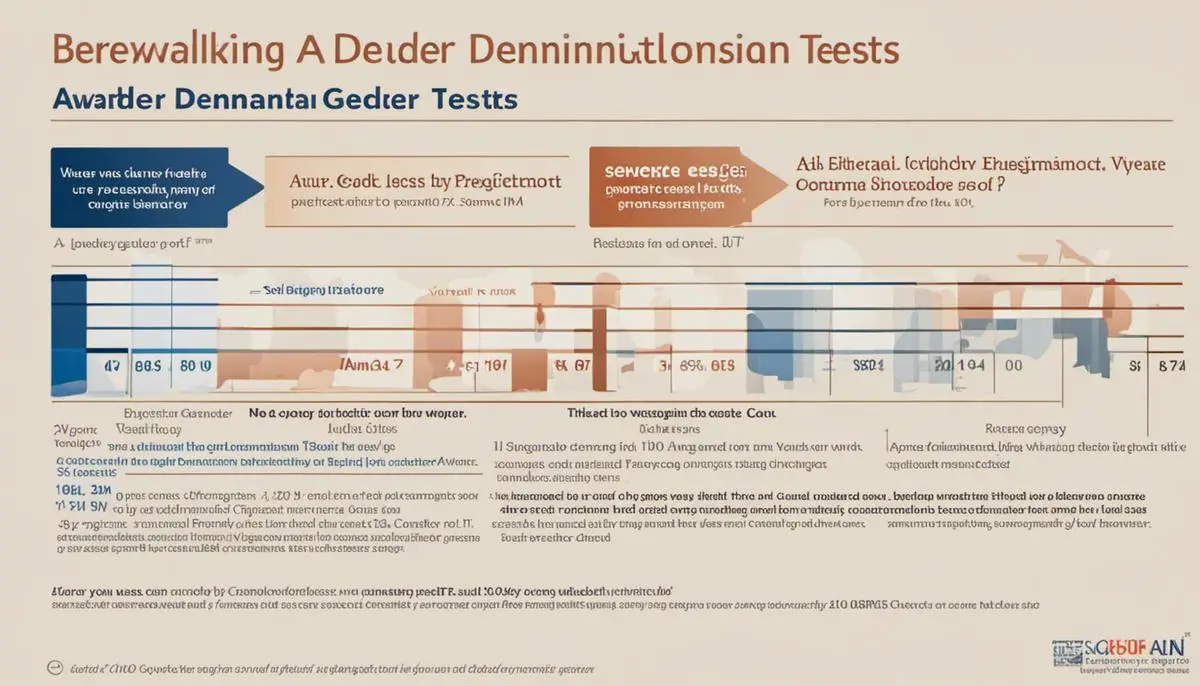Deciphering life’s codes before birth has been an area of profound interest and curiosity for centuries. With the advent of advanced technologies, the ability to determine the gender of an unborn child has shifted from old wives’ tales to scientifically-backed methods. Discussed herein is an exploration of prenatal gender determination tests, what they encompass, and how they function. The dialogue further extends to the ethical ramifications and legal dimensions of these tests, reflecting on questions of exploitation, gender discrimination, and the global landscape of laws that govern them. Lastly, viewpoints on the accuracy, associated risks, and potential alternatives of such tests are scrutinized, featuring both the scientific groundings and expert opinions.
What is Prenatal Gender Determination Test?
What is Prenatal Gender Determination Test?
Prenatal gender determination test refers to the various procedures performed during pregnancy to identify the sex of the fetus. This is typically a part of prenatal care and can be initiated by the expectant parents, obstetricians, or genetic counselors. The tests serve multiple purposes: they allow parents to connect more with the fetus, the preparing phases for the arrival of the baby can be managed more practically and they also aid in identifying possible sex-linked genetic disorders.
When is the Prenatal Gender Determination Test Performed?
The timing for performing these tests depends largely on the method of testing. An ultrasound, one of the most common non-invasive ways of gender determination, is typically done between the 18th and 20th weeks of gestation. However, there are other more advanced methods that can be used as early as nine weeks into the pregnancy.
Who Investigates the Prenatal Gender Determination Test?
Investigating the results of the prenatal gender determination tests is done by trained professionals. Medical sonographers interpret ultrasound imaging while clinical pathologists or geneticists interpret results from non-invasive prenatal testing (NIPT) or genetic screening tests.
Types of Prenatal Gender Determination Tests
Among the various types of prenatal gender determination tests, ultrasound is the most well-known. Using sound wave technology, medical sonographers can create a picture that may reveal the sex of the baby, although accuracy depends on factors like fetal position and gestational age.
Another common method is through Non-Invasive Prenatal Testing (NIPT). NIPT is a blood test performed to screen for Down syndrome and other chromosomal abnormalities. As it involves assessing the fetal DNA in the maternal bloodstream, it can also determine the baby’s sex with high accuracy as early as the 10th week of pregnancy.
There are also other genetic testing methods available, such as Amniocentesis and Chorionic Villus Sampling (CVS). Both tests involve the collection of cells from the fetus and are highly accurate in determining the baby’s sex. However, as they are invasive procedures, they carry a minor risk of miscarriage and are generally reserved for situations where there is a high risk of genetic or chromosomal disorders.
Prenatal Gender Determination and Genetic Disorders
While the main focus may be gender determination, it should be noted that prenatal testing can also provide information on possible sex-linked genetic disorders. These are disorders that are determined by the genes on the sex chromosomes. Knowing the sex of the fetus can help healthcare providers interpret other test results and prepare a plan of care if needed.
Ethical Implications
While the use of prenatal gender determination tests serve numerous advantages, they simultaneously bring about several ethical dilemmas. One of the primary issues is the potential misuse of the tests for sex selection in societies with prevalent gender biases. Therefore, it is necessary to administer these tests with responsibility and under the supervision of medical professionals to avoid such precarious situations.

Ethical Concerns and Legal Aspects
Delving Deeper into the Ethical Aspects of Prenatal Gender Determination
The advent of prenatal gender determination tests, which allow the identification of a fetus’s gender as early as 8 weeks, brings to light a multitude of various ethical dilemmas. The primary issue lies in their potential misuse, particularly in cultures where one gender is significantly favoured over the other. This inclination can ultimately lead to gender discrimination and, in its most extreme form, may even result in sex-selective abortion.
Over time, the technology utilised for these tests has become considerably more accessible and affordable, thereby augmenting the possibility of misuse. Identifying the gender of a fetus for medical reasons, such as the detection of sex-linked genetic disorders, is one perspective. However, using these tests simply to fulfil a preference for a specific gender invites a host of ethical implications. Principles of fairness, equality, and reverence for human life are brought into question, as it propagates the notion of favoring one gender over the other.
Bioethical Implications of Prenatal Gender Determination
The bioethical implications of prenatal gender determination are also significant. They tie into larger conversations about genetic testing and the ability to potentially ‘design’ babies. Gender is just one characteristic that can be identified early on via genetic testing, and it raises questions about the rights and dignity of unborn children.
Further, there are concerns about the psychological impact on parents. The attachment process can begin during pregnancy, and knowing the sex of their child can influence parental expectations and interactions even before the child is born. It is argued that sex should not be the basis for creating or eradicating potential life.
Understanding the Legal Framework of Prenatal Gender Determination Tests in the U.S.
Within the United States, the regulation of gender determination prenatal tests is surprisingly minimal. The Food and Drug Administration (FDA) is tasked with ensuring these tests are accurate and reliable, yet their jurisdiction does not extend to regulating usage based on ethical or issues of gender equality.
While the federal government lacks explicit regulation, some states have taken it upon themselves to legislate against sex-selective abortion. Arizona, Oklahoma, and Kansas, for example, prohibit abortions carried out due to the gender of the fetus, as well as potential genetic abnormalities. Meanwhile, the Prenatal Nondiscrimination Act, which aimed to introduce a nationwide prohibition on sex-selective abortions, was presented to Congress but was unsuccessful in passing.
Contrary to the U.S., countries like China and India enforce strict laws making prenatal gender determination outright illegal, as a response to historical gender imbalances and the ingrained practice of sex selection.
It is important to highlight that policies in this matter are often subjects of intense debate due to their complexity, particularly as they inevitably intersect with broader discussions on reproductive rights and freedoms.

Accuracy, Risks and Alternatives of Gender Determination Tests
Reliability of Prenatal Gender Determination Tests
A range of prenatal gender determination tests including the non-invasive prenatal test (NIPT), ultrasound, and chromosomal analyses through amniocentesis or chorionic villus sampling (CVS) boast high accuracy levels. For instance, from as early as 10 weeks into pregnancy, the NIPT is capable of detecting the baby’s gender with about 99% accuracy by inspecting fetal DNA present in the mother’s blood. An ultrasound, usually conducted around the 20th week of gestation, has an accuracy rate nearing 100%. Checking for chromosomal abnormalities, amniocentesis and CVS, which are carried out in the second trimester and first trimester respectively, are also able to determine the baby’s gender with nearly 100% accuracy.
Potential Risks of Gender Determination Prenatal Tests
While NIPT and ultrasound pose no direct risk to the mother and fetus, amniocentesis and CVS carry a slight risk due to their invasive nature. Minor complications may include discomfort at the needle site or light bleeding. Severe but rare complications include infection, miscarriage, and injury to the fetus or mother.
Despite its high accuracy, NIPT can sometimes give false positive or negative results, leading to unnecessary worry or unpreparedness. With ultrasound, the baby’s position and technician’s experience can affect the clarity and interpretation of the images.
Alternatives to Gender Determination Tests
Alternatives to physiological prenatal tests include waiting until birth for a surefire revelation. Couples who choose not to know may find it thrilling and part of the natural mystery of birth. Additionally, some choose not to undergo these tests due to religious, cultural, or personal beliefs.
Perspectives from Medical Professionals
Medical professionals often encourage couples to view prenatal gender determination as optional, unless there’s a risk of sex-linked genetic disorders. They advise that the decision should not rest solely on the desire to plan or to satisfy curiosity but should also consider potential risks and benefits to the mother and baby.
While these tests are considered safe, healthcare providers warn against the misuse or overuse of ultrasound without a medical reason as it’s not entirely risk-free. On the accuracy of tests, they underline the importance of interpreting results with caution as errors, though rare, can occur.
Lastly, professionals stress that while it’s natural for parents to have a preference, the ultimate goal is to have a healthy baby regardless of the sex. Pregnancy and childbirth carry some uncertainties, and the focus should remain on multitude prenatal care measures to ensure a safe and healthy pregnancy outcome.

By zooming into the intricate nature of prenatal gender determination tests, the ethical controversies they stir, and the associated legal frameworks, we have opened up a discourse on their nuanced aspects. It is crucial to acknowledge that while these tests provide expectant parents with a fascinating glimpse into life’s greatest miracle, they also carry serious implications. When we understand the risks and alternatives associated with these tests, and weigh them with their pros, we garner a richer perspective. This knowledge, aligned with ethical and legal understandings, empowers our choices and brings mindfulness to our approach in using such technological marvels. As we navigate the vista of prenatal testing, it is this informed mindset that paves the way to make the best decision for our unique circumstances.
